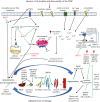Therapeutic potential of heat shock protein induction for muscular dystrophy and other muscle wasting conditions
- PMID: 29203713
- PMCID: PMC5717528
- DOI: 10.1098/rstb.2016.0528
Therapeutic potential of heat shock protein induction for muscular dystrophy and other muscle wasting conditions
Abstract
Duchenne muscular dystrophy is the most common and severe of the muscular dystrophies, a group of inherited myopathies caused by different genetic mutations leading to aberrant expression or complete absence of cytoskeletal proteins. Dystrophic muscles are prone to injury, and regenerate poorly after damage. Remorseless cycles of muscle fibre breakdown and incomplete repair lead to progressive and severe muscle wasting, weakness and premature death. Many other conditions are similarly characterized by muscle wasting, including sarcopenia, cancer cachexia, sepsis, denervation, burns, and chronic obstructive pulmonary disease. Muscle trauma and loss of mass and physical capacity can significantly compromise quality of life for patients. Exercise and nutritional interventions are unlikely to halt or reverse the conditions, and strategies promoting muscle anabolism have limited clinical acceptance. Heat shock proteins (HSPs) are molecular chaperones that help proteins fold back to their original conformation and restore function. Since many muscle wasting conditions have pathophysiologies where inflammation, atrophy and weakness are indicated, increasing HSP expression in skeletal muscle may have therapeutic potential. This review will provide evidence supporting HSP induction for muscular dystrophy and other muscle wasting conditions.This article is part of the theme issue 'Heat shock proteins as modulators and therapeutic targets of chronic disease: an integrated perspective'.
Keywords: heat shock proteins; muscular dystrophy; skeletal muscle wasting.
© 2017 The Author(s).
Conflict of interest statement
G.S.L. is a consultant for N-Gene Research Laboratories Inc. (USA).
Figures

Similar articles
-
Alterations in Notch signalling in skeletal muscles from mdx and dko dystrophic mice and patients with Duchenne muscular dystrophy.Exp Physiol. 2014 Apr;99(4):675-87. doi: 10.1113/expphysiol.2013.077255. Epub 2014 Jan 17. Exp Physiol. 2014. PMID: 24443351
-
Effects of muscular dystrophy, exercise and blocking activin receptor IIB ligands on the unfolded protein response and oxidative stress.Free Radic Biol Med. 2016 Oct;99:308-322. doi: 10.1016/j.freeradbiomed.2016.08.017. Epub 2016 Aug 20. Free Radic Biol Med. 2016. PMID: 27554968
-
Exercise, heat shock proteins and insulin resistance.Philos Trans R Soc Lond B Biol Sci. 2018 Jan 19;373(1738):20160529. doi: 10.1098/rstb.2016.0529. Philos Trans R Soc Lond B Biol Sci. 2018. PMID: 29203714 Free PMC article. Review.
-
Expression of heat-shock/stress proteins in Duchenne muscular dystrophy.Muscle Nerve. 1995 Jan;18(1):23-31. doi: 10.1002/mus.880180105. Muscle Nerve. 1995. PMID: 7799995
-
Chaperoning heat shock proteins: proteomic analysis and relevance for normal and dystrophin-deficient muscle.Proteomics Clin Appl. 2014 Dec;8(11-12):875-95. doi: 10.1002/prca.201400015. Epub 2014 Aug 28. Proteomics Clin Appl. 2014. PMID: 24895218 Review.
Cited by
-
Regulatory Role of the Transcription Factor Twist1 in Cancer-Associated Muscle Cachexia.Front Physiol. 2020 Jun 23;11:662. doi: 10.3389/fphys.2020.00662. eCollection 2020. Front Physiol. 2020. PMID: 32655411 Free PMC article. Review.
-
Cellular pathogenesis of Duchenne muscular dystrophy: progressive myofibre degeneration, chronic inflammation, reactive myofibrosis and satellite cell dysfunction.Eur J Transl Myol. 2023 Oct 16;33(4):11856. doi: 10.4081/ejtm.2023.11856. Eur J Transl Myol. 2023. PMID: 37846661 Free PMC article.
-
Complexity of skeletal muscle degeneration: multi-systems pathophysiology and organ crosstalk in dystrophinopathy.Pflugers Arch. 2021 Dec;473(12):1813-1839. doi: 10.1007/s00424-021-02623-1. Epub 2021 Sep 22. Pflugers Arch. 2021. PMID: 34553265 Free PMC article. Review.
-
Heat shock proteins as modulators and therapeutic targets of chronic disease: an integrated perspective.Philos Trans R Soc Lond B Biol Sci. 2018 Jan 19;373(1738):20160521. doi: 10.1098/rstb.2016.0521. Philos Trans R Soc Lond B Biol Sci. 2018. PMID: 29203706 Free PMC article.
-
Acquired Resilience: An Evolved System of Tissue Protection in Mammals.Dose Response. 2018 Dec 27;16(4):1559325818803428. doi: 10.1177/1559325818803428. eCollection 2018 Oct-Dec. Dose Response. 2018. PMID: 30627064 Free PMC article. Review.
References
-
- Lynch GS. 2011. Sarcopenia – age-related muscle wasting and weakness: mechanisms and treatments, 1st edn Berlin, Germany: Springer.
-
- Swiderski K, Lynch GS. 2015. Therapeutic potential of orphan drugs for the rare skeletal muscle diseases. Expert Opin. Orphan Drugs 3, 1397–1425. (10.1517/21678707.2015.1085858) - DOI
Publication types
MeSH terms
Substances
LinkOut - more resources
Full Text Sources
Other Literature Sources

